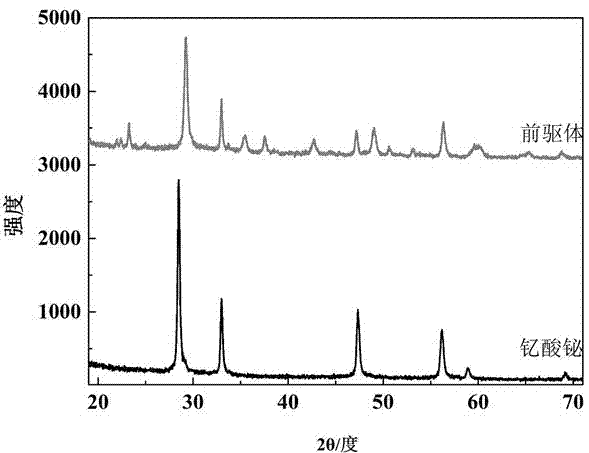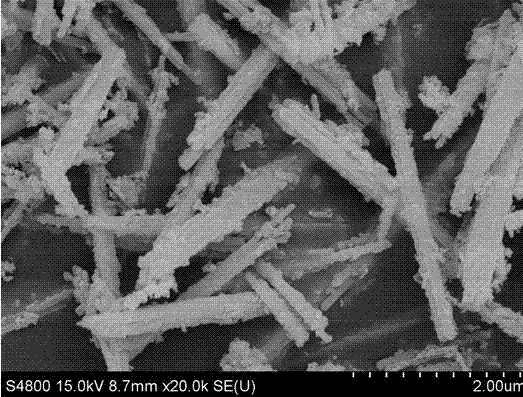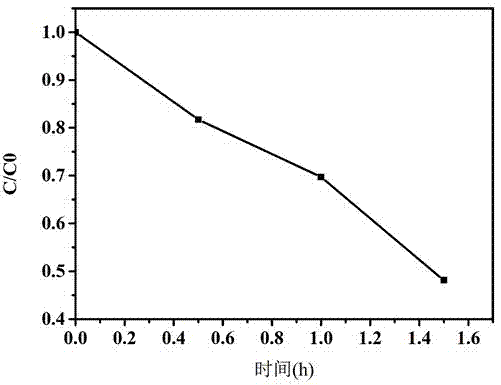Bismuth yttrate nanorod as well as preparation method and application thereof
A technology of nanorods and bismuth yttrium oxide, which is applied in the field of bismuth yttrium oxide nanorods and its preparation, can solve the problems of poor bismuth yttrium oxide morphology and achieve low cost, short reaction time and good reproducibility
- Summary
- Abstract
- Description
- Claims
- Application Information
AI Technical Summary
Problems solved by technology
Method used
Image
Examples
Embodiment 1
[0026] (1) Weigh bismuth nitrate and yttrium nitrate and dissolve in 10ml, 0.1mol / L -1 In dilute nitric acid, the masses of the bismuth nitrate and yttrium nitrate are 0.2425g and 0.1916g respectively.
[0027] (2) The mixed solution in step 1 was ultrasonically stirred for 1 h to obtain a clear and transparent liquid.
[0028] (3) Transfer the liquid obtained in step 2 to a polytetrafluoroethylene-lined reactor, and 4 ?H 2 O to adjust the pH value to 8; add water to 80% of the reactor volume.
[0029] (4) The reaction kettle in step 3 was kept in the temperature range of 180 oC, and reacted at constant temperature for 48 hours to obtain a precipitate.
[0030] (5) Wash the precipitate obtained in step 4 alternately with water and ethanol, and centrifuge.
[0031] (6) The centrifuged product in step 5 is calcined at a high temperature to remove impurities to obtain pure-phase bismuth yttrium nanorods. The high-temperature calcination temperature is 450°C, the calcination t...
Embodiment 2
[0033] (1) Weigh bismuth nitrate and yttrium nitrate and dissolve in 10ml, 0.1mol / L -1 In dilute nitric acid, the masses of the bismuth nitrate and yttrium nitrate are 0.2425g and 0.1916g respectively.
[0034] (2) The mixed solution in step 1 was ultrasonically stirred for 1 h to obtain a clear and transparent liquid.
[0035] (3) Transfer the liquid obtained in step 2 to a polytetrafluoroethylene-lined reactor, and 4 ?H 2 O to adjust the pH value to 8.5; add water to 80% of the reactor volume.
[0036] (4) Keep the reaction kettle in step 3 in the temperature range of 200 oC, and react at constant temperature for 24 hours to obtain a precipitate.
[0037] (5) Wash the precipitate obtained in step 4 alternately with water and ethanol, and centrifuge.
[0038] (6) The centrifuged product in step 5 is subjected to high-temperature calcination to remove impurities to obtain pure-phase bismuth yttrium nanorods. The high-temperature calcination temperature is 550°C, the calcin...
Embodiment 3
[0040] (1) Weigh bismuth nitrate and yttrium nitrate and dissolve in 10ml, 0.1mol / L -1 In dilute nitric acid, the masses of the bismuth nitrate and yttrium nitrate are 0.2425g and 0.1916g respectively.
[0041] (2) The mixed solution in step 1 was ultrasonically stirred for 1 h to obtain a clear and transparent liquid.
[0042] (3) Transfer the liquid obtained in step 2 to a polytetrafluoroethylene-lined reactor, and 4 ?H 2 O to adjust the pH value to 9; add water to 80% of the reactor volume.
[0043] (4) Keep the reaction kettle in step 3 in the temperature range of 240 oC, and react at constant temperature for 16 hours to obtain a precipitate.
[0044] (5) Wash the precipitate obtained in step 4 alternately with water and ethanol, and centrifuge.
[0045] (6) The centrifuged product in step 5 is calcined at a high temperature to remove impurities to obtain pure-phase bismuth yttrium nanorods. The high-temperature calcination temperature is 650°C, the calcination time is...
PUM
| Property | Measurement | Unit |
|---|---|---|
| Diameter | aaaaa | aaaaa |
Abstract
Description
Claims
Application Information
 Login to View More
Login to View More - R&D
- Intellectual Property
- Life Sciences
- Materials
- Tech Scout
- Unparalleled Data Quality
- Higher Quality Content
- 60% Fewer Hallucinations
Browse by: Latest US Patents, China's latest patents, Technical Efficacy Thesaurus, Application Domain, Technology Topic, Popular Technical Reports.
© 2025 PatSnap. All rights reserved.Legal|Privacy policy|Modern Slavery Act Transparency Statement|Sitemap|About US| Contact US: help@patsnap.com



